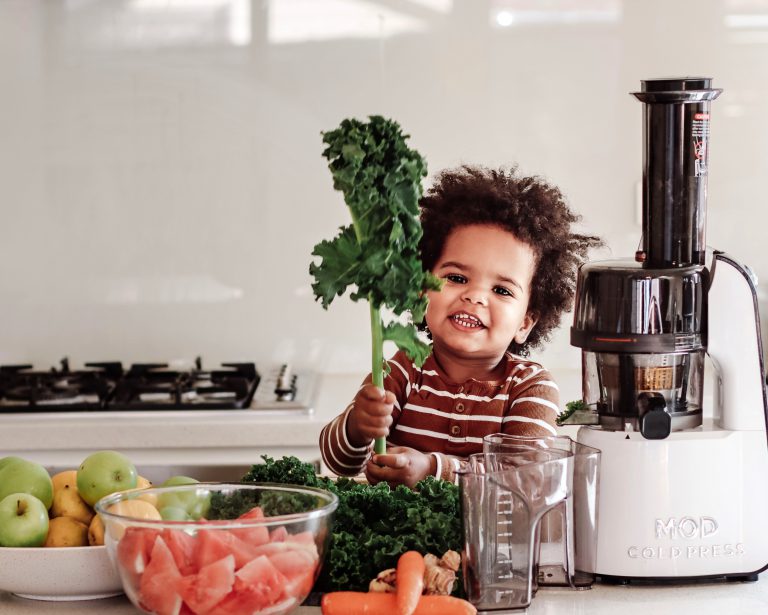Tips for Feeding Fussy Eaters – Plus 2 Fail-Safe Recipes

Tips for Feeding Fussy Eaters – Plus 2 Fail-Safe Recipes
Summer is just around the corner, delivering an abundance of delicious new season fruit and vegetables. The warmer days make it the perfect time to incorporate more fresh produce into our diets, but how do we achieve this for the younger or pickier members of our family?
Encouraging kids to eat well is an ongoing battle and cause of stress in many households. We all know our children should eat a varied diet with an emphasis on vegetables and fruit, however actually getting kids to “eat the rainbow” can prove to be a real struggle. According to a recent study, only around 4% of Australian children get their recommended vegetable intake each day (Australian Institute of Health and Welfare, 2020). Fruit fares better thankfully, with around 75% of children meeting that target every day.
It’s clear that kids need to eat more vegetables (and sometimes also fruit) but what is a parent to do when you can barely sneak a lettuce leaf into their sandwich without them sniffing it out? Whilst it may be a challenge, there is a lot that parents can do to support them towards better eating.
To begin with, educate yourself about the daily requirements of fruit and vegetables for your children, which changes as they grow older. A study by the Royal Children’s Hospital suggests that only 1 in 4 parents understand the vegetable requirements for their children each day (Royal Children’s Hospital National Child Health Poll, 2017). According to the Australian Institute of Health and Welfare (2018) “the minimum recommended number of serves of vegetables per day is 2½ for children aged 2–3; 4½ for children aged 4–8; 5 for children aged 9–11, females aged 12 and over and males aged 70 and over; 5½ for males aged 12–18 and 51–70 years; and 6 for males aged 19–50. The minimum recommended number of serves of fruit per day is 1 for children aged 2–3, 1½ for children aged 4–8, and 2 for people aged 9 and over.”
Secondly, modelling healthy and varied eating ourselves is incredibly important. Children are like sponges, they really do absorb many of our habits, particularly around food. Start small, by reaching for a piece of fruit or a handful of nuts as a snack, when you might otherwise go for chips or something sweet. Extend this to mealtime as well, why not try new recipes and ingredients you haven’t used before? Your willingness to eat healthily and try new things is an amazing way to encourage your kids to do the same.
While you’re in the kitchen, invite your children to help you in age-appropriate ways. Even the youngest of kids can gather and wash produce, while older ones can read out recipes, be taught to safely slice ingredients and stir the pot. Having your children assist you in choosing what’s on the menu greatly increases their engagement in the process, making it more likely that they’ll try new things.
You can also extend their interest in food by sparking their awareness of where it comes from. Why not visit the farmer’s market together and talk about seasonal produce, plant your own seedlings at home or enjoy a day out picking berries at a local farm? Learning more about how food is grown, and how it gets onto our plate, is an important life lesson and gives greater appreciation to the entire process.
For picky children (and even adults!) an easy and fun way to boost their nutrient intake is to incorporate fresh, cold-pressed juices into their diet. Skip the supermarket juice, and make your own with a juicer like the MOD Cold Press Juicer. You can decide exactly what goes in (and what stays out) of their juice, and you can easily conceal the taste of vegetables (like cucumber or carrot) with fruits (like oranges or apples). Keep the sugar down by sticking to a ratio of 20% fruit and 80% vegetables and involve them in the process too, they will love it! You can even turn the juice into icy poles, a perfect way to boost nutrition and hydration on a warm day. See our peachy icy poles recipe below for inspiration.
Looking for more juice recipe ideas? Our sneaky greens kids juice recipe is perfect. One of the key ingredients is kale – a green, leafy vegetable that has many health benefits such as strengthening the body’s immune system, outer body, and bones. Antioxidants found in kale can help slow the aging process by preventing free radical cells from damaging the skin. Kale is also a great source of Vitamin A which can promote healthy and glowing skin, hair, and nails.
Another bonus of juicing is that you can repurpose the juice pulp into your family meals. Add fibre and nutrients to any soup or casserole by adding the pulp during cooking. You can also turn the pulp into vegetable patties or include it in sausage rolls. Sneaky nutrition at its finest!
There are lots of ways to encourage healthy eating for all members of the family. With a combination of education and modelling combined with a few sneaky tactics, your kids will be well on their way to meeting their nutritional targets.
Recipes:
Peachy Icy Poles
3 peaches, de-stoned
2 carrots
1 Continental cucumber
Sneaky Greens Kids Juice
6 kale leaves
2 Lebanese cucumbers
1 apple, cut into wedges
½ lemon, peeled
Author: Lara Hibble
Inhouse Health Coach at Australian Wellness brand MOD Appliances, Lara is a qualified Integrative Nutrition Health Coach with further studies specialising in Gut Health. She is passionate about helping individuals to thrive with purpose in aligning and achieving their health and lifestyle goals.
Sources:
Australian Institute of Health and Welfare. (2020). Australia’s children. Retrieved from https://www.aihw.gov.au/reports/children-youth/australias-children
Australian Institute of Health and Welfare. (2018). Australia’s health 2018. Canberra: AIHW.
Royal Children’s Hospital (2017) National Child Health Poll. Retrieved from https://www.rchpoll.org.au/academic-papers/












